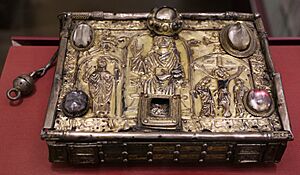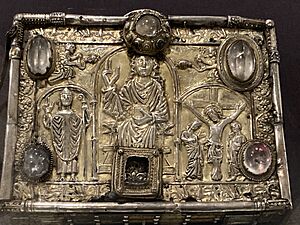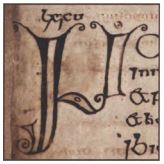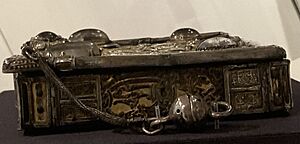Cathach of St. Columba facts for kids
Quick facts for kids Royal Irish Academy |
|

Folio 48r, Cathach of St. Columba
|
|
| Also known as | The Battler |
|---|---|
| Type | Psalter |
| Date | Before AD 561 |
| Place of origin | Ireland |
| Language(s) | Vulgar Latin |
| Material | Vellum |
| Size | 27cm x 19cm |
| Format | Folio |
| Condition | Poor |
| Script | Insular |
The Cathach of St. Columba, also known as the Cathach (which means "the Battler"), is a very old Irish psalter. A psalter is a book containing the Book of Psalms from the Bible. This manuscript was created in the late 500s.
It is the oldest surviving manuscript from Ireland. It is also the second oldest Latin psalter still existing anywhere in the world.
The Cathach is kept inside a special, fancy metal box called a cumdach. This box is like a reliquary or carrying case for holy books. The original box was made in the late 1000s. It was later updated and decorated more in the 1300s and 1500s. This special shrine belonged to the leaders of the O'Donnell Clan. They were powerful lords in Tír Chonaill (now County Donegal). They used the Cathach as a symbol to inspire their warriors and protect them in battle.
In 1691, after the Treaty of Limerick, the Cathach was taken to Europe. It did not return to Ireland until 1813. When the cumdach was opened that year, the manuscript was found again. It was in very poor condition. However, it was carefully restored in 1982. The remaining pages were rebound and placed on new vellum leaves. Even after this work, the Cathach is still badly damaged. Only 58 vellum leaves survive from an original 110.
Today, the manuscript is kept safe at the Royal Irish Academy in Dublin. The cumdach, its special metal box, is at the National Museum of Ireland.
Contents
What is the History of the Cathach?

The Cathach was very important to the O'Donnell Clan. They believed it would protect them and help them win battles. Before a fight, a chosen monk or holy person would wear the Cathach and its shrine around their neck. This person would then walk three times around the O'Donnell warriors. This ritual was meant to bring good luck and victory.
Over time, the manuscript was passed down through the O'Donnell family. Brigadier-General Daniel O'Donnell inherited it. He believed it was a powerful charm that would bring victory if carried into battle. Daniel O'Donnell fought for King James II in Ireland. After a peace treaty, he went to France. There, he served King Louis XIV in the Irish Brigade.
While in France, Daniel O'Donnell put the Cathach in a silver case. He left it for safekeeping in a monastery in Belgium. In his will, he said it should be returned to whoever could prove they were the true Chief of Clan O'Donnell. In 1802, an Irish abbot helped return it to Sir Neale O'Donnell in County Mayo. Later, in 1842, Sir Richard Annesley gave the precious relic to the Royal Irish Academy.
The pages of the manuscript were stuck together for many years. They were carefully separated at the British Museum in 1920. More restoration work was done in 1980–81 to preserve it.
What Does the Cathach Look Like?
The Manuscript Pages
The Cathach manuscript contains parts of the Vulgate version of the Psalms. Specifically, it has Psalms 30:13 to 105:13. People traditionally believe that St. Columba (also known as Colum Cille), who died in 597 AD, wrote it.
The manuscript is thought to have been created between 560 and 600 AD. It measures about 27 centimeters by 19 centimeters. Today, only 58 pages, called folios, remain. The complete book would have had around 110 pages.
The decoration in the Cathach is simple but beautiful. It is mainly found on the first letter of each Psalm. These initial letters are larger than the rest of the text. They are made with thick black lines and decorated with special patterns. These patterns include trumpet shapes, spirals, and guilloche (intertwined ribbons). The letters are often outlined with orange dots. Some parts of the letters are colored white, red, pink, or orange.
An art historian named Françoise Henry said these initial letters are very important. She called them a "landmark" in the history of Irish manuscript art. She thought that if the lost front page were found, it would teach us even more about Irish art. After the large initial letter, the next few letters gradually get smaller. They then blend into the main text.
Irish manuscripts often used unique writing styles. The Cathach was mostly written by one person. This scribe used a clear, rounded writing style. They also added strong, wedge-shaped marks (called serifs) to the upright strokes of the letters. A calligraphy expert, Timothy O'Neill, noted that the scribe used a special quill. This quill was held at a flat angle. This allowed them to make thick downward strokes and thin horizontal lines.
The Cumdach (Book Shrine)

The cumdach is a special box made to protect the Cathach. It is an oblong wooden box with hinges. It is covered with decorative bronze and gold-plated silver plates. It also has mounts that hold glass and crystal pieces. Before this fancy shrine, the manuscript was probably kept in a leather bag called a "tiag." This was similar to the bag made for the 9th-century Breac Maodhóg.
The shrine was built in three main stages. The first part was finished between 1062 and 1098. This happened in Kells, County Meath. At this time, the manuscript was owned by the O'Donnells and was their most important relic. A new main front panel was added between 1350 and 1375. This panel was made of gold-plated metal with raised designs (repoussé). It shows a large seated Christ in Majesty. On the right side, there is a scene of the Crucifixion. On the left, there is a saint, probably Columba. More decorations and repairs were done in the 1500s. Another repair happened in 1723 when Daniel O'Donel had it in Paris.
The cumdach has been used continuously since it was first made. This includes by its traditional keepers, the Magroarty family. One member of this family was killed in 1497 when the shrine was captured. Today, the cumdach is part of the collection at the National Museum of Ireland.
Side Panels of the Shrine
The long and short side panels of the shrine have different parts added at different times. The long sides mostly show traditional animal designs and abstract patterns. The main decorations on the short sides have more complex patterns. These patterns were influenced by the Ringerike style of Viking art.
Inscriptions on the Shrine
The shrine has several inscriptions written on it. Some of the letters are badly damaged. The words also have misspellings and shortened forms. These inscriptions were changed or added to later. They are written in Irish and go clockwise along the borders of the back of the shrine.
The inscriptions are signed by the goldsmith, Sitric Mc Meic Aeda. He states that he built the shrine under the direction of Domnall Mac Robartaigh. Domnall was an abbot at Kells. He had retired before he died in 1094, but the inscription still calls him "successor of Kells." Domnall was working for Cathbarr Ua Domnaill, who paid for the shrine.
The full inscription has been translated as:
- "A prayer for Cathbarr Ua Domnaill who had this shrine made"
- "and for Sitric son of Mac Aeda who made [it]"
- "and for Domnall Mac Robartaig, coarb of Kells, by whom it was made."
We don't know much about Sitric, except that his father was also a craftsman at Kells. Because there are misspellings and inconsistencies in the writing, some people think Sitric might not have been able to read or write well. They believe he might have just copied a script given to him.
See also
- Springmount Bog Tablets, a 7th-century Irish psalter written on wooden wax tablets
- Faddan More Psalter, a 9th-century psalter found in a peat bog in 2006







